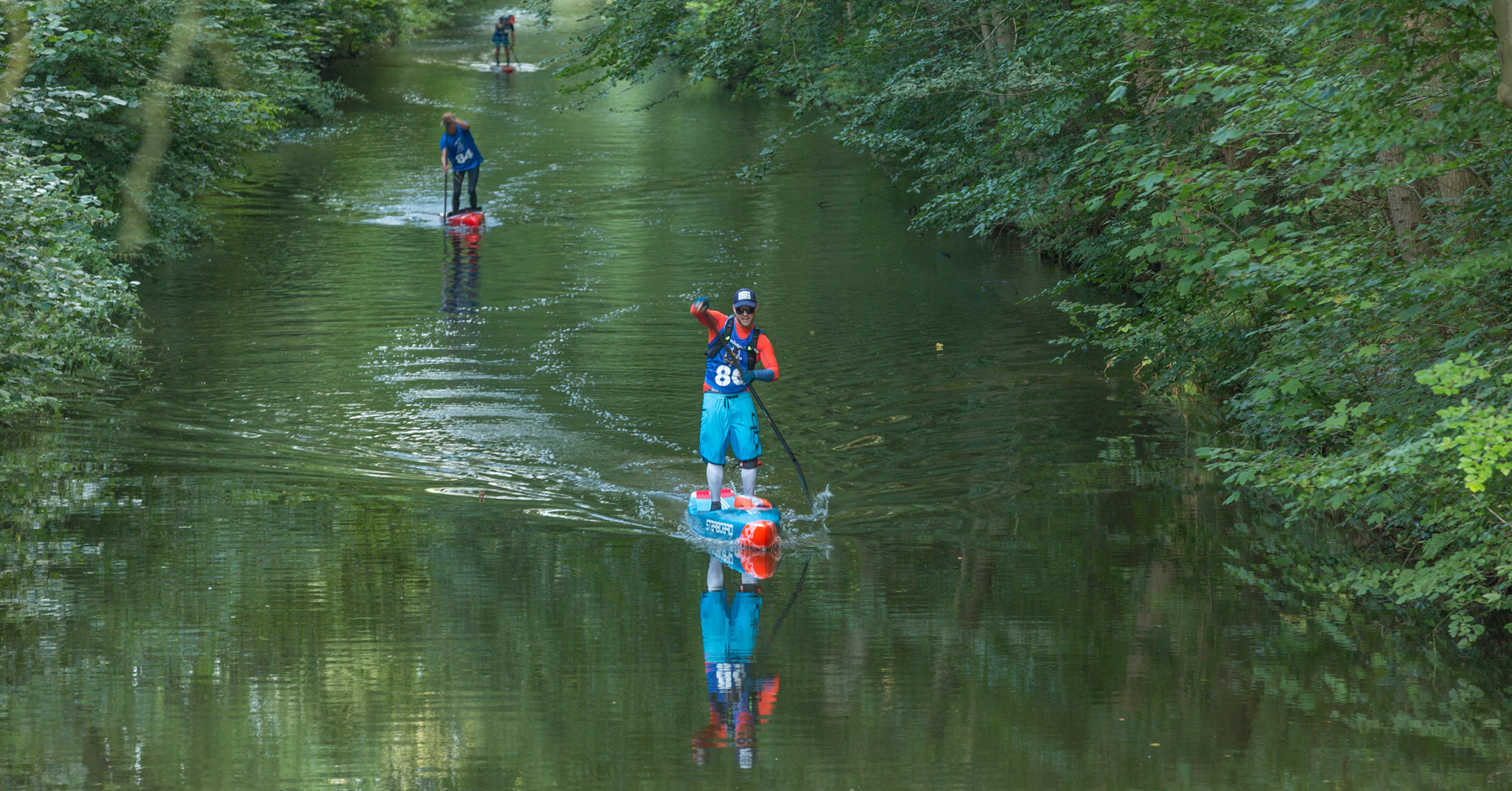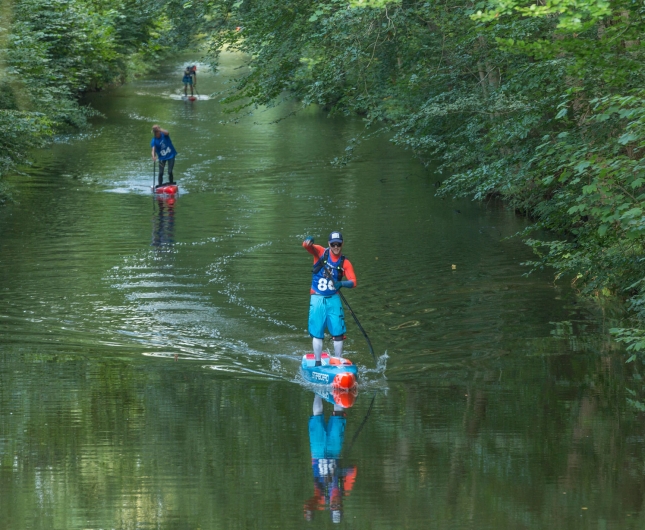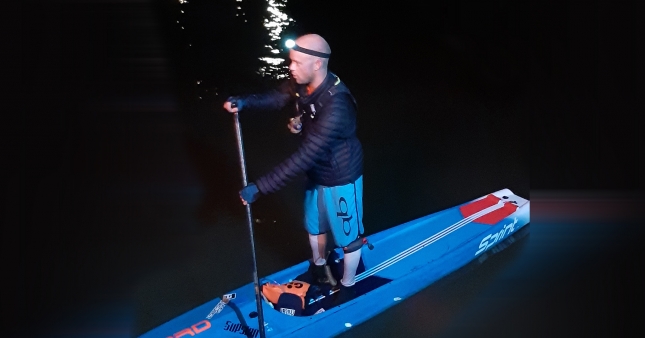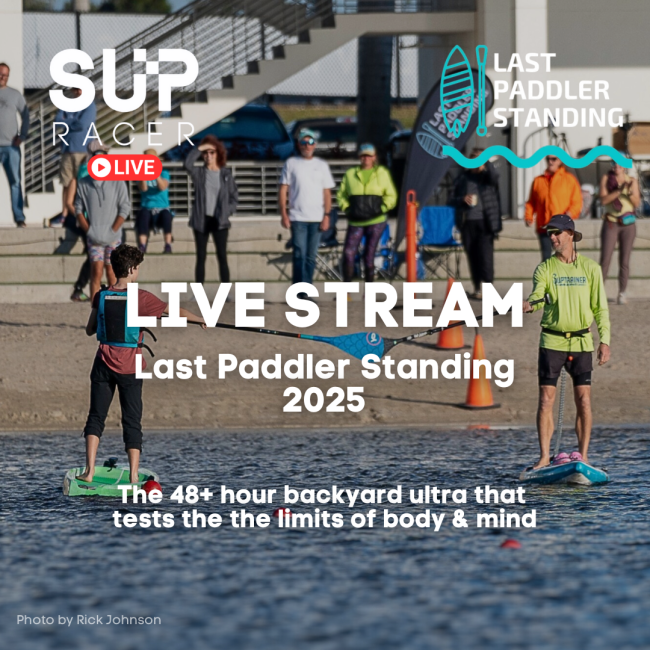
“The wind was speaking to me.” How I paddled 38 hours non-stop and set a bizarre new record
My hands were actually OK this time. They’re usually the first thing to go. The blisters, the swelling, the cramps. But this year they escaped relatively unscathed even with a pair of cheap gloves that seemed to do more harm than good when wet.
My feet weren’t so lucky.
It was about 20 hours into the race when I realised an uncomfortable fact: I couldn’t stand up anymore.
The soles of my feet were so swollen, so painful, so warped like a surrealist Dali painting that I could barely stand. I was taking breaks every 30 minutes or just paddling on my knees to find relief. The arches of my feet had crumpled into feeble wrinkles of tired skin. My heel bones felt like blunt spears poking through weary, water-soaked leather. It was 6am Sunday morning, I hadn’t slept all night and I still had another 18 hours of non-stop paddling ahead of me.
I was in trouble.
To say this year’s “Non-Stop” SUP 11-City Tour was a challenge would be an understatement. There were 19 solo paddlers and 4 relay teams on the start line Saturday morning. Incredibly, only half a dozen withdrew mid-race. The rest of us endured record times on the water in what became a battle for survival after headwinds turned a nice day into a nightmare.
The non-stop version of this famous race is exactly what it sounds like: Instead of a five-day, five-stage race, the non-stop competitors do the entire 204km (127 mile) course in one go. All day, all night and all day again.

Happier times… the first day started calmly enough; that’s actually the champion Niek van der Linde about to pass me — he started in the group two hours behind but had already caught me by the seven-hour mark (photo: Mayola Dijksman)
The “race” had started well. I’d even entertained the idea of finishing in less than 30 hours.
After a relatively calm first leg of 45km, we hit the dreaded lakes. The series of wide open bodies of water that not only offer zero protection from the wind but routinely whip up small waves to destroy your pace.
“Three.. point.. six.. kilometres-per-hour.” said the unhelpful woman from Runtastic, my phone’s GPS tracking app that had been shouting out my pace every 60 seconds to keep me focused. Earlier, I’d been cruising at just under 8km/h and well within 30-hour pace. The contrast was crushing.
After huddling under a bridge for 20 minutes to escape one particularly brutal rain squall, I finally made it off the lakes around sunset on day one. I was alone – all but two paddlers were well ahead of me at this point – but I felt good. The hardest part of the course was behind me, and I’d convinced myself the wind would die down after dark.
How naïve.
The next six hours became a test of strength, stamina and patience as the headwinds produced an invisible wall that drained me physically and tried to destroy me mentally.
It wasn’t so much that there was headwind, it’s that there rarely wasn’t. It didn’t seem to matter which direction I paddled, the wind was always in my face. I turned 90 degrees around a corner expecting sweet relief only to be met with an even stronger gale. I was paddling through a 50km wind tunnel going the wrong way.
I was moving so slow that I got excited whenever my Runtastic girl told me I’d nudged above 4km/h (that’s not even 2.5mph). I’d been so frustrated that I actually told the wind to “FUCK OFF!” at one point. I calculated that if I didn’t escape this nightmare soon I’d be paddling well into Monday.
And then the wind started speaking to me.
After a 50km leg that should have taken six hours had turned into a 10-hour-plus voyage of Odyssean proportions, my mind began to lose its grip on reality. I was utterly convinced the only way to stop the headwind was to understand what it was trying to tell me. I was in paddling purgatory.
Around 1am Sunday morning, 15 hours into the race, I finally stopped fighting. I listened to the wind.
It may sound like a tired mind playing tricks on its master, but I was convinced I knew what the wind was trying to tell me. I promised to heed its advice, and soon after that the wind had stopped.
I paddled the next few hours through a Twilight Zone. With the wind moving on to other patients, the canals became glassy and reflective. The rain had disappeared, the clouds were parting and I could see stars from trillions of miles away glowing in a black mirror just metres away.
But as relaxing as those few hours were, I was still only halfway through my 204km quest. And I still hadn’t slept.
The only thing keeping me awake was my fearless support team (which consisted of one person). They stayed up til 7am to ensure I didn’t run out of food or water, and that I didn’t quit; without them, I’m pretty sure I would have. They slept four hours and met me again before lunchtime Sunday. We were both doing an ultra.
By Sunday afternoon I knew I was going to make it. After I started I was never going to stop. But in the deep, dark despair of that midnight headwind nightmare, I was seriously tempted.
Clouds parted after lunch, blue skies appeared and it was so bright I even stopped to put on some sunscreen. What a difference 12 hours makes.
I reached the town of Dokkum around 7.30pm Sunday evening. This is where the fourth stage finishes in the traditional 11 Cities race. After Dokkum it’s a simple, 27-kilometre “sprint” to the end.
My voyage into Dokkum had been delayed 15 minutes after I stopped for a coffee with my support “team” — there are so many picturesque little canal towns that we only see for a minute in the five-day race. This time I promised myself I’d stop once or twice (or seven times) and enjoy my surroundings. The soles of my feet also needed their routine rest.
The sun was slowly dipping below the horizon as I exited Dokkum. Midnight was my self-imposed deadline and by 9pm I was down to 21km. The only competitor behind me had retired in Dokkum – a Frenchman named Christian Hermouet who was suffering so badly he couldn’t stand up – so I was literally the last man standing.
There was actually a safety cut-off at 8pm after which no escort boats were supposed to be on the water, but the sweeper boat had surplus sympathy and told me they’d follow me all the way til the end.
With two hours to go, I entered a narrow, ghostly canal where smoke rose from the water and trees closed in overhead like an alien penguin trying to give me an awkward hug.
This is where I really started hallucinating.
Every little cottage along the canal – every 100 metres or so – had a real person standing in the garden looking out at me. I was convinced. I could make out their facial features, their height, even the clothes they were wearing.
Except nobody was ever there.
It did strike me as odd that an old man would be sitting in his backyard, wearing just a t-shirt, staring out at the canal on a cold Sunday night. Maybe he was there to cheer me on? As I got nearer, I realised it was a ball hanging from a rope beneath the patio ceiling.
Who needs drugs when you’ve got the ultras?

My “I’m tripping, aren’t I?” face… (photo: Rhythm Munjal)
The clock inched closer to midnight as I inched closer to the start/finish town of Leeuwarden. I could see the city lights, and I could almost smell the sheets on my bed that I so desperately wanted to crawl into.
I calculated that I should finish about 10 minutes before midnight, but I also miscalculated the distance.
When I reached what I believed to be the penultimate bridge, where there would have only been 400 metres to go, a maritime clock read “23:57” and I lunged into a desperate sprint for the finish. 400 metres, three minutes. I didn’t care how long I’d been paddling or that I could barely stand on my raw heels, I knew I could make it.
It was about 60 seconds later, sweat pouring down my face and steam rising off my shoulders in the crisp evening air, that I realised I was at the wrong bridge. I still had almost a kilometre to go.
At five minutes past midnight, I crossed the line. A small team from the event had waited to cheer me home. Barely able to walk, I hobbled off my board and finally sat down to rest for good.
38 hours, 5 minutes and 41 seconds.
It was a record slow time for a stand up paddler in the non-stop race. But the record I’m most proud of is that I became the first person to ever finish this race on a Monday…
I only ever set out to just finish these ultras. Time becomes irrelevant as soon as you paddle into double digit hours. At least for me. Some people actually were racing.
Out the front of the non-stop field one man had been setting an extraordinary race pace that resulted in a new record time of 24 hours and 20 minutes.
Niek van der Linde.
Niek not only defeated the elements (he was paddling 9.2km/h into the headwind on Saturday afternoon) he also vanquished the “King of the Ultras” Bart de Zwart. It was a titanic performance, and one that I got to see up close when Niek came flying past me around the seven hour mark. He’d started two hours behind me.
Niek’s heroics were matched in the women’s by Janneke Smits who won her third non-stop title to add to her 2014 five-day crown. Janneke now has four titles, which places her alongside Bart de Zwart as the most successful athletes in 11 City Tour history.
But everyone that finishes this race deserves a medal, and that’s exactly what they get. The famous 11 Cities “cross” that’s based on the original medal from the ‘Elfstedentocht’ (11 City Tour) ice-skating race that was founded over a hundred years ago and has since spawned 11-City Tours in over two dozen sports.
It’s now Wednesday and we’ve just finished the first stage of the five-day race. I still can’t feel some of my toes, and I’m still seeing faces when I sleep, but I’m also still the only paddler to ever finish this race on a Monday. And that makes me a little proud — because to finish on Monday, you have to finish.
Here are the finishing times (or retirement points) of every crazy brave paddler that took on the Non-stop Tour this year.
Solo women
1st: Janneke Smits (31 hours 23 minutes 26 seconds)
2nd: Micheline Hauchecorne (32:42:09)
3rd: Anne-Marie Reichman (35:23:33)
Solo men
1st: Niek van der Linde (24:20:32)
2nd: Bart de Zwart (26:18:00)
3rd: Carsten Schuur (31:06:53)
4th: Göran Gustavsson (31:25:10)
5th: Kevin Kohn (31:28:24)
6th: Stephane Bentoumi (31:43:50)
7th: Stefan Grosch (33:31:09)
8th: Takaaki Ishii (34:21:11)
9th: Andreas Svensson (36:15:00)
10th: Christopher Parker (38:05:42)
11th: Christian Hermouet (DNF: 177km)
12th: Carsten Schroer (DNF: 145km)
13th: Sebastiaan de Ranitz (DNF: 100km)
14th: Andres Rivera Cespedes (DNF: 90km)
15th: Miquel Roige (DNF: 70km)
16th: Ian Stieltjes (DNF: 65km)
Women’s team
1st: Heleen & Tineke (33:48:53)
Mixed teams
1st: SUP Skool Leeuwarden (29:41:57)
2nd: 3BAY KYC (31:22:47)
3rd: Mistral SUP Skool Leeuwarden (38:15:00)




You must be logged in to post a comment.